배철현의 요가수트라 강독 1 : 삼매
배철현 (지은이)김영사2023-01-16
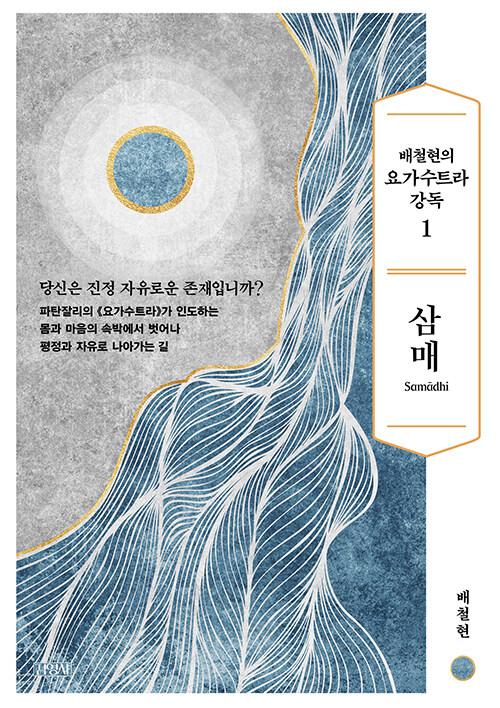






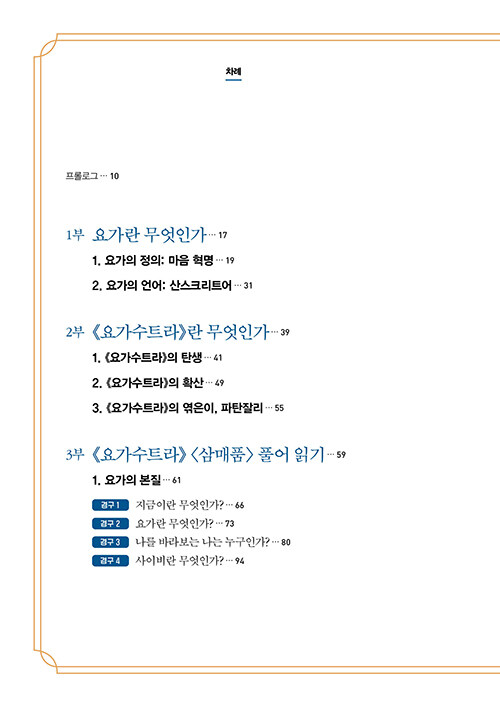
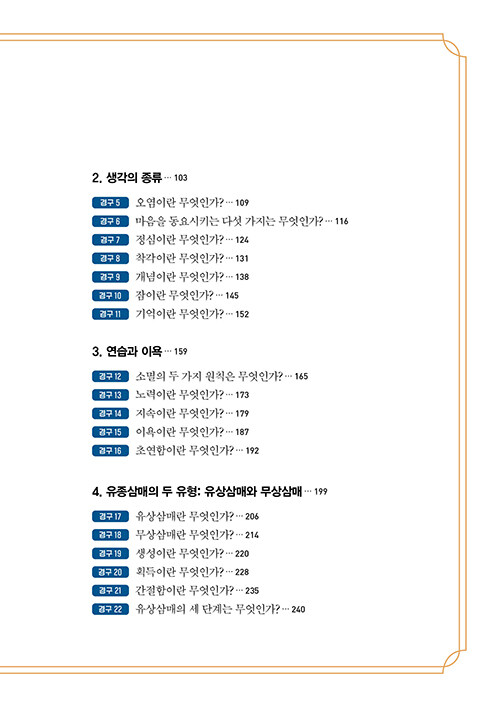

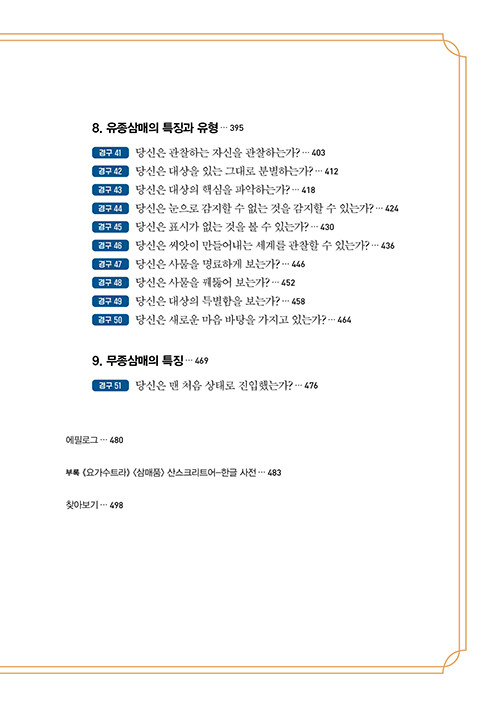
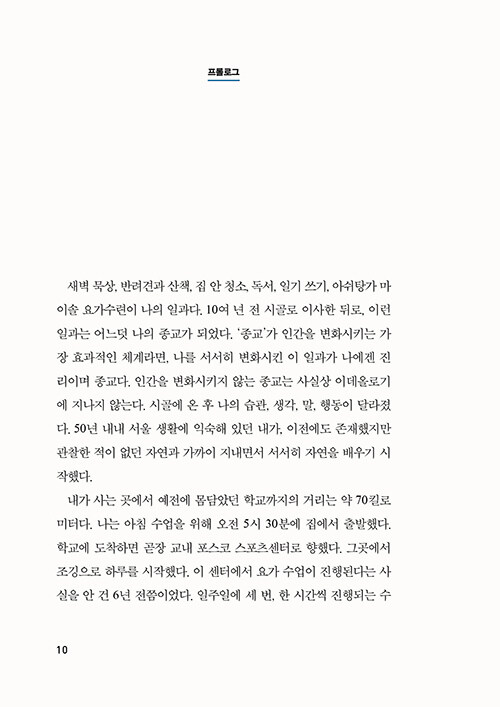
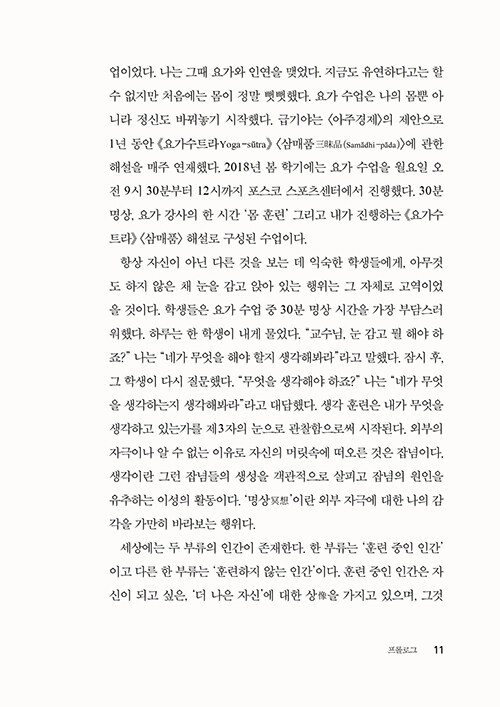




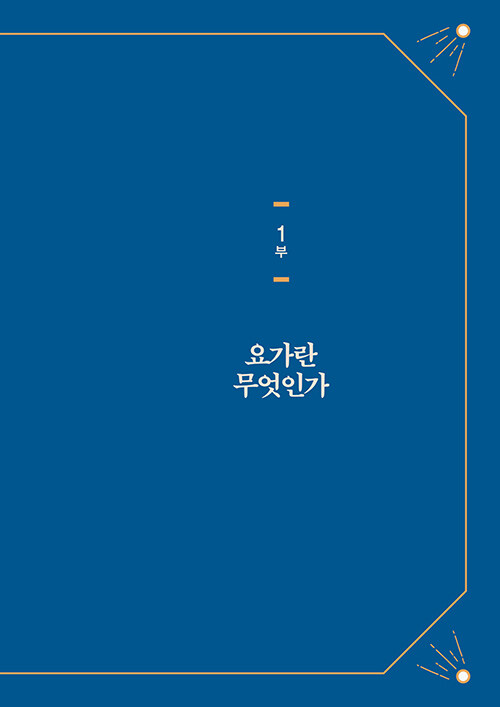


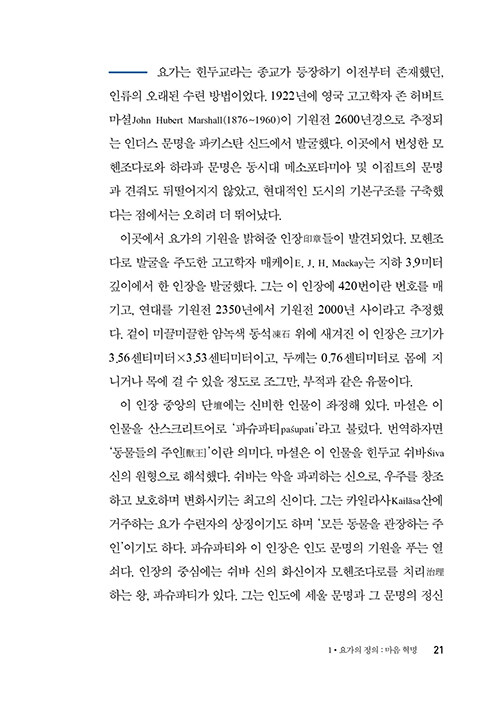

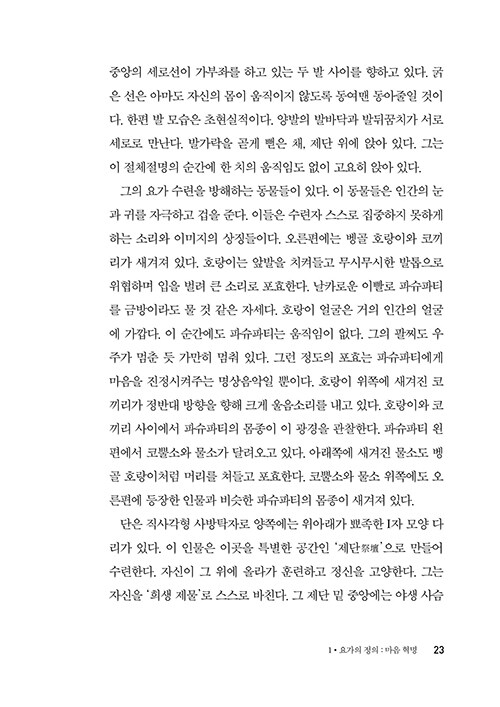



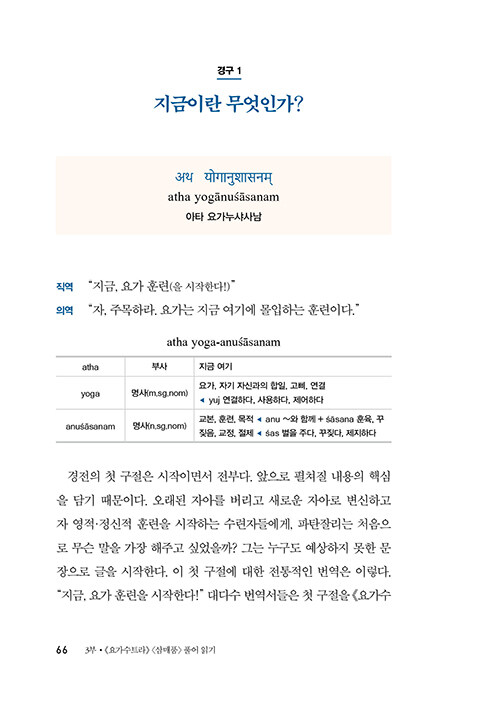

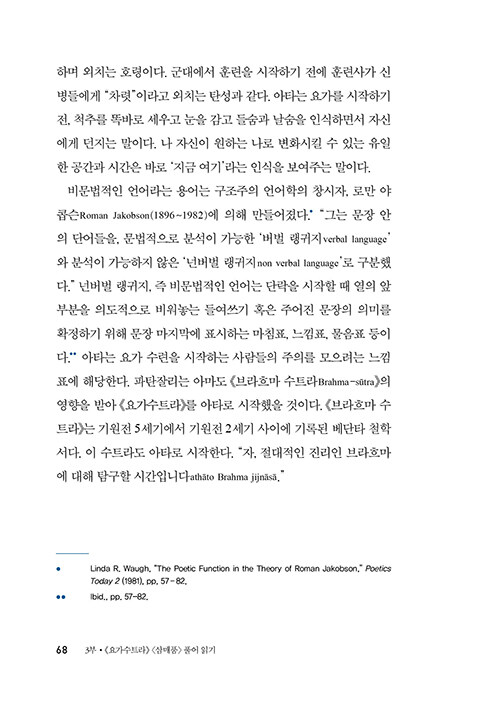


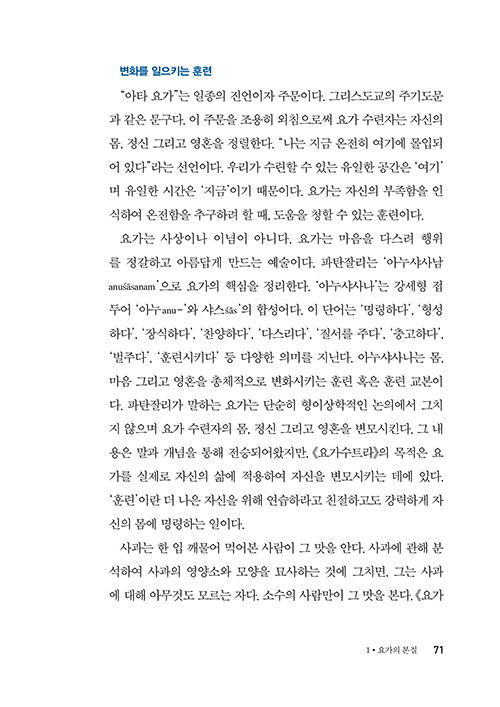



정가
23,800원
판매가
21,420원 (10%, 2,380원 할인)
마일리지
1,190원(5%) + 멤버십(3~1%)
+ 5만원이상 구매시 2,000원

배송료
무료
107
양탄자배송
밤 10시까지 주문하면 내일 아침 7시 출근전 배송
(중구 서소문로 89-31 기준) 지역변경
건강운동 주간 7위, 종교/역학 top100 11주|
Sales Point : 3,448

이 책 어때요?
전자책
15,300원

카드/간편결제 할인

무이자 할부

소득공제 970원

수량
장바구니 담기
바로구매
선물하기
보관함 +
중고 등록알림 신청

중고로 팔기




기본정보
504쪽
책소개
《요가수트라》는 인류의 가장 오래된 마음 수련 방법인 요가의 요체를 체계적으로 설명한 경전이다. 《요가수트라》는 〈삼매품〉, 〈수련품〉, 〈현현품〉, 〈독존품〉의 4개 장, 총 195행의 경구로 이루어져 있다. 국내에서 유일한 고전문헌학자 배철현은 제1장 〈삼매품〉 51개 경구에 대해 해석과 풀이를 먼저 소개한다.
이 책은 인도철학의 관점에서만 집중한 기존의 《요가수트라》 해설서와는 그 궤를 달리한다. 고대 신화와 종교, 철학, 심리학, 언어학은 물론, 니체의 《차라투스트라는 이렇게 말했다》, 단테의 《신곡》 등 여러 고전과 함께 동서양의 인문학을 모두 아우르며, 《요가수트라》를 통해 인간 정신의 해방을 위한 자유의 길을 우리에게 보여준다.
《요가수트라》를 기록한 문자인 데바나가리와 로마자로 표기된 산스크리트 단어의 어원 및 문법을 상세히 소개하여 산스크리트어 원전을 한 문장씩 깊이 있게 해설하는 것은 물론, 특히 셈족어와 인도-이란어 및 그리스어, 라틴어 등 고대 언어 전문가로서의 실력을 십분 발휘하여, 독자의 올바른 원전 이해를 돕고 있다.
〈삼매품〉의 51개 경구는 앞으로 전개될 《요가수트라》의 주제와 요가 수련의 핵심 개념을 담고 있다. 한 주 또는 하루에 한 구절씩 그 의미를 새기고 몸과 마음을 수련해보자. 나의 생각과 말, 행동을 무의식적으로 장악하고 있는 집착에서 벗어나, 본연의 자기를 발견하고 영적인 자유를 얻게 될 것이다.
목차
프롤로그
1부 요가란 무엇인가
1. 요가의 정의: 마음 혁명
2. 요가의 언어: 산스크리트어
2부 《요가수트라》란 무엇인가
1. 《요가수트라》의 탄생
2. 《요가수트라》의 확산
3. 《요가수트라》의 엮은이, 파탄잘리
3부 《요가수트라》 〈삼매품〉 풀어 읽기
1. 요가의 본질
경구 1. 지금이란 무엇인가?
경구 2. 요가란 무엇인가?
경구 3. 나를 바라보는 나는 누구인가?
경구 4. 사이비란 무엇인가?
2. 생각의 종류
경구 5. 오염이란 무엇인가?
경구 6. 마음을 동요시키는 다섯 가지는 무엇인가?
경구 7. 정심이란 무엇인가?
경구 8. 착각이란 무엇인가?
경구 9. 개념이란 무엇인가?
경구 10. 잠이란 무엇인가?
경구 11. 기억이란 무엇인가?
3. 연습과 이욕
경구 12. 소멸의 두 가지 원칙은 무엇인가?
경구 13. 노력이란 무엇인가?
경구 14. 지속이란 무엇인가?
경구 15. 이욕이란 무엇인가?
경구 16. 초연함이란 무엇인가?
4. 유종삼매의 두 유형: 유상삼매와 무상삼매
경구 17. 유상삼매란 무엇인가?
경구 18. 무상삼매란 무엇인가?
경구 19. 생성이란 무엇인가?
경구 20. 획득이란 무엇인가?
경구 21. 간절함이란 무엇인가?
경구 22. 유상삼매의 세 단계는 무엇인가?
5. 신에게 헌신
경구 23. 헌신이란 무엇인가?
경구 24. 신은 누구인가?
경구 25. 전지란 무엇인가?
경구 26. 구루란 누구인가?
경구 27. 말이란 무엇인가?
경구 28. 옴 낭송의 목적은 무엇인가?
경구 29. 내관이란 무엇인가?
6. 방해와 산만 극복
경구 30. 무엇이 요가 수련을 방해하는가?
경구 31. 요가 훼방꾼들이 만들어낸 증상은 무엇인가?
경구 32. 요가를 수련하는 단 하나의 원칙은 무엇인가?
7. 평정심
경구 33. 당신에게는 이 네 가지 마음이 있는가?
경구 34. 당신은 숨을 내쉬기 전에 잠시 멈추는가?
경구 35. 당신은 대상을 무심하게 바라보는가?
경구 36. 당신의 마음에는 슬픔이 없는가?
경구 37. 당신의 생각은 자유로운가?
경구 38. 당신은 깊은 잠이 드는가?
경구 39. 당신의 취미는 무엇인가?
경구 40. 당신은 만사에 평정을 유지하는가?
8. 유종삼매의 특징과 유형
경구 41. 당신은 관찰하는 자신을 관찰하는가?
경구 42. 당신은 대상을 있는 그대로 분별하는가?
경구 43. 당신은 대상의 핵심을 파악하는가?
경구 44. 당신은 눈으로 감지할 수 없는 것을 감지할 수 있는가?
경구 45. 당신은 표시가 없는 것을 볼 수 있는가?
경구 46. 당신은 씨앗이 만들어내는 세계를 관찰할 수 있는가?
경구 47. 당신은 사물을 명료하게 보는가?
경구 48. 당신은 사물을 꿰뚫어 보는가?
경구 49. 당신은 대상의 특별함을 보는가?
경구 50. 당신은 새로운 마음 바탕을 가지고 있는가?
9. 무종삼매의 특징
경구 51. 당신은 맨 처음 상태로 진입했는가?
에필로그
부록 《요가수트라》 〈삼매품〉 산스크리트어-한글 사전
찾아보기
접기
책속에서
P. 69‘요가’라는 단어는 이중적이다. ‘결합’과 ‘분리’라는 상반된 의미를 지니기 때문이다. 요가의 첫 번째 의미는 ‘결합’이다. ‘요가yoga’는 인도・유럽어 어근 *yuk-에서 비롯되었는데, 이는 기원전 12세기경, 아리아인들이 전쟁에 나갈 동물들을 훈련하기 위한 ‘밧줄’이나 ‘고삐’를 의미한다. 초기 아리아인들은 야생... 더보기
P. 90~91파탄잘리는 《요가수트라》에서 요가의 목적이 본연의 자신을 수련하는 것이라고 주장한다. 그는 아트만이나 푸루샤란 용어 대신 드라슈투후draṣṭuḥ를 사용한다. 이 단어는 ‘보다’, ‘배우다’, ‘이해하다’란 동사 ‘드리스dṛś’에서 파생되었다. ‘드리스’가 말하는 ‘보는 행위’는 ... 더보기
P. 43~44고대 히브리인들은 상거래에 꼭 필요한, 세세한 눈금이 달린 자를 만들었다. 중동지방 늪지대에서 자라는 긴 갈대를 꺾어 그 마디에 눈금을 새겼다. 이 자를 고대 히브리어로 ‘카네qāeh’라고 불렀다. 모두가 동의하는 기준을 제시하는 카네는 공동체 삶을 원활하게 움직이는 힘이 되었다. 카네를 차용하여 고대 그리스어 단어 ‘카... 더보기
P. 264요가 수련자가 수련할 때 집중하는 대상이 바로 이슈바라다. 그에게 신이란 최선을 다해 모든 것을 바칠 수 있는 존재이자 소원의 궁극적 대상이 되는 존재다. ‘프라니다나pranidhāa’에서 ‘프라니prani’는 뒤에 오는 개념을 강조하는 접사고, ‘다dhā’는 ‘우주의 질서에 알맞은 자리에 두다’라는 동사이며, ... 더보기
P. 306명상은 가만히 앉아 잡념을 떠올리는 행위나 자신의 이익을 극대화하기 위해 약육강식의 전략을 짜는 행위가 아니다. 명상은 오늘이라는 절체절명의 시간에 자신의 존재 이유를 찾는 거룩한 행위다. 그것은 내가 속한 가족, 이웃, 공동체 그리고 국가 안에서 자신을 위한 최선을 찾는 행위다. 나는 정해진 시간에 정해진 장소에서 인내와 지구력... 더보기
더보기
저자 및 역자소개
배철현 (지은이)
저자파일
신간알리미 신청
고전문헌학자이자 작가. 인류 최초 문자들의 언어인 셈족어와 인도-이란어를 전공했다. 기원전 5세기 페르시아제국의 다리우스 대왕이 남긴 삼중쐐기문자 비문에 관한 연구로 하버드대학교에서 박사학위를 취득했다. 건명원(建明苑) 원장과 서울대학교 종교학과 교수를 역임했다. 인류가 남긴 경전과 고전을 연구하여 후대를 위한 강의와 집필 활동에 몰입하고 있다.
블로그 <배철현의 매일묵상>(blog.naver.com/eduba)에 일상의 소소한 관찰을 글로 적고, 유튜브 채널 <배철현의 더코라THE CHORA>에는 동서양 경전과 고전을 통해 얻은 혜안을 영상으로 올리고 있다. 2020년 교육기관 ‘더코라(www.thechora.com)’를 설립하여 청소년과 예술 청년들을 위한 인문학교 ‘서브라임’과 경영인들을 위한 ‘코라클래스’를 운영하고 있다. 자신과의 심오한 대면과 자기-극복 훈련이 포스트-코로나 시대 새로운 문명의 틀이라고 믿는다. 아슈탕가 마이솔 요가 훈련을 통한 영감으로 《배철현의 요가수트라 강독》을 집필하고 있다.
저서로 《타르굼 옹켈로스 창세기》《신의 위대한 질문》《인간의 위대한 질문》《인간의 위대한 여정》《배철현의 위대한 리더》그리고 위대한 개인을 발굴하기 위한 에세이 시리즈 《심연》《수련》《정적》《승화》등이 있다. 접기
최근작 : <배철현의 요가수트라 강독 1 : 삼매>,<승화 : 더 높은 차원의 삶을 위하여>,<배철현의 위대한 리더> … 총 36종 (모두보기)
출판사 소개
김영사
도서 모두보기
신간알리미 신청

최근작 : <거인의 옥편>,<나는 천국을 보았다>,<삶은 몸 안에 있다>등 총 1,721종
대표분야 : 요리만화 1위 (브랜드 지수 378,117점), 사회/역사/철학 1위 (브랜드 지수 769,281점), 과학 2위 (브랜드 지수 769,638점)
출판사 제공
책소개

마음 훈련의 전통이 집대성된 《요가수트라》
마음의 평정과 영적인 자유의 길을 제시
인도의 다양한 정통 철학 유파들 가운데 현대까지 생동하면서 영적인 해방과 자유, 몸과 마음의 균형 잡힌 건강을 제시한 것이 바로 요가이다. 파탄잘리가 편집한 《요가수트라》는 인도의 오랜 마음 훈련 전통이 한 권으로 엮인 경전으로, 전체 4개 장, 총 195개의 경전 구절로 이루어져 있다.
《요가수트라》의 목적은 흔히 ‘요가’로만 알려진 전인적이고 통합적인 심신 수련을 통해 완전히 다른 존재로 거듭나는 것이다. 이를 위해 《요가수트라》는 인간의 의식에 대한 새로운 관점을 제안한다. 인간을 고통 속으로 몰아넣는 축적된 경험과 기억을 알아차리고, 이 속박으로부터 벗어나는 길을 우선 제시한다. 평정과 자유는 과거에 대한 집착을 제거해야 가능하기 때문이다. 요가 수련자는 이를 위해 명상하고 몰입하며, 명상을 통해 자신의 일상을 장악하여 이상적인 모습으로 변화한다.
종교, 철학, 심리학, 언어학 등
인문학의 시선에서 깊이 고찰한 가장 현대적 해석
파탄잘리가 편집한 《요가수트라》의 간결하게 응축된 경구는 다양한 해석이 가능한, 함축적인 의미를 지니고 있다. 이러한 경구를 이해하기 위해 후대에 여러 권의 주석서가 집필되었다. 이조차도 그대로 이해하기 어려워, 주석에 대한 주석, 즉 많은 복주서가 그 후 다시 집필되었다.
《배철현의 요가수트라 강독》은 인류가 지금까지 쌓아온, 동양과 서양의 고전 인문학을 총설하여 풀이한 현대적 주석이라 할 수 있다. 고전문헌학자이자 종교학자인 저자는 고대에서부터 현대에 이르기까지 신화와 종교, 철학, 심리학, 언어학, 문학 등 동서양의 고전 인문학을 총집대성하여 다양한 관점에서 《요가수트라》의 의미를 깊고 상세하게 고찰하고 더불어 일상의 삶에서 그 실천방법을 제시한다.
파탄잘리는 제1장 〈삼매품〉의 경구 3에서 ‘진정한 자신’이라는 의미로 ‘드라슈투후(draṣṭuḥ)’를 사용한다. 인도철학에서 비슷한 의미로 쓰는 ‘아트만’이나 ‘푸루샤’ 대신 ‘드라슈투후’를 쓴 이유는 무엇이었을까. 저자는 ‘드라슈투후(진정한 자신)’를 플라톤의 《국가》에 등장하는 ‘동굴의 비유’나 마르쿠스 아우렐리우스가 《명상록》에 언급한 ‘헤게모니콘’, 이마투엘 칸트의 ‘물자체(物自體)’ 등과 비교하며 ‘드라슈투후’의 숨은 뜻을 더 풍부하고 입체적으로 전달하고 있다.
산스크리트 원문을 바탕으로 한
고전문헌학자의 더 깊고 넓은 《요가수트라》 풀이
고대 설형문자와 인도-이란어, 셈족어(아람어), 그리스어 및 라틴어에 해박한 지식을 보유하고 있는 저자 배철현의 고대 오리엔트 언어 전문가로서의 면모가 본문에 잘 드러난다. 저자는 《요가수트라》 〈삼매품〉 51개 경구의 데바나가리를 소개하고, 산스크리트 단어를 문법적으로 풀이하며, 그중 중요한 단어는 어원을 상세히 분석하여 경구 자체의 이해를 더욱 깊이 할 수 있도록 돕는다. 또한, 단어에 대한 깊이 있는 어원 분석은, 경구에 대한 전통적인 해설을 답습하지 않고 원전이 지닌 본래의 의미를 되살려 그 뜻을 쉽게 이해할 수 있게 한다.
경전의 첫 구절은 시작이면서 전부다. 앞으로 펼쳐질 내용의 핵심을 담기 때문이다. 오래된 자아를 버리고 새로운 자아로 변신하고자 영적・정신적 훈련을 시작하는 수련자들에게, 파탄잘리는 처음으로 무슨 말을 가장 해주고 싶었을까? 그는 누구도 예상하지 못한 문장으로 글을 시작한다. 이 첫 구절에 대한 전통적인 번역은 이렇다. “지금, 요가 훈련을 시작한다!” 대다수 번역서들은 첫 구절을 《요가수트라》 전체의 제목으로 번역했다. ‘아타atha’는 ‘지금’, ‘요가누샤사남yogāuśāanam’은 ‘요가 훈련’이란 뜻이다. 학자들은 이 문장을 《요가수트라》 전체의 제목으로 ‘요가 훈련’이라고만 번역하기도 한다. 나는 이 구절을 제목이라기보다는 위대한 경전의 첫 문장이자 요가의 정신을 드러내는 핵심 문장으로 번역하고 싶다. 필자의 번역은 이렇다.
“자, 주목하라. 요가는 ‘지금 여기’에 몰입하는 훈련이다.”
- 본문 66-67쪽 중에서
산스크리트를 전혀 모르더라도, 천천히 한 구절씩 읽어나가면, 독자 스스로 원전을 해독하며 뜻을 곱씹는 즐거움을 느낄 수 있다.
《요가수트라》 전체의 요지가 집약된 첫 번째 장
〈삼매품〉이 안내하는 평정과 자유로 가는 길
《요가수트라》는 〈삼매품〉, 〈수련품〉, 〈현현품〉, 〈독존품〉의 4개 장으로 구성돼 있다. 이 가운데, 〈삼매품〉을 해설한 《배철현의 요가수트라 강독 1 - 삼매》이 먼저 선보였다. 이후 순차적으로 〈수련품〉, 〈현현품〉, 〈독존품〉에 대한 해설이 독자들을 찾아갈 예정이다.
《요가수트라》 제1장 〈삼매품〉은 요가의 요체를 집약하여 소개하는 도입부이다. 〈삼매품〉에서는 요가의 복합적인 의미와 본질적인 개념을 짚는 것으로 먼저 시작한다. 인간의 언행을 지배하는 생각의 종류를 구별하고 설명하면서, 그런 생각(잡념)을 소멸시키는 방법을 제시하고, 그를 통해 평정심에 도달하는 과정 또한 밝힌다.
요가가 추구하는 마음의 평정과 영적인 자유는 체계적이고 논리적인 명상 수련을 통해서 도달할 수 있다. 소용돌이치는 마음을 다스려 삼매가 초래하는 평정을 획득하고, 영적인 자유를 유지하는 방법을 〈삼매품〉은 자세히 보여주고 있다.
요가 수련자는 명상하고 몰입하여 먼저 일상을 있는 그대로 인식해야 한다. 그런 다음, 자신의 일상을 장악하여 자신이 원하는 이상적인 모습, 본연의 자신에 도달할 수 있다. 요가는 나의 생각, 말, 행동을 무의식적으로 또 습관적으로 장악하는 집착에서 나를 해방시키는 수련이다. 나의 최선을 발견하는 장소인 ‘마음의 심연’을 볼 수 없도록 훼방하는 집착은 무엇인가? 나는 지금 무엇을 생각하는가?
파탄잘리는 51행으로 이루어진 〈삼매품〉 을 편집하면서, 요가 수련자의 몸・마음・영혼이 서서히 바뀔 수 있도록 유구한 인도 전통에서 선별한 산스크리트어 단어들을 차근차근 소개하였다. 한 단어의 심오한 의미는 그것에 대한 한국어 등가어가 아니라, 그 단어가 지닌 심오한 어원 분석을 통해 살펴볼 수 있다. 예들 들어 ‘사마디samādhi’라는 산스크리트어 단어는 ‘삼매三昧’라는 한자를 통해 들어온 등가어가 아니라, ‘누구나 가진 정성스런 마음mā을 우주의 질서에 맞게 가지런히sam 놓을 때dhi, 드러나는 초월적인 경지’라는 의미다. 나는 독자들과 함께 단어가 품은 심오한 의미를 추적하고 이를 삶에 적용시켜 매일 조금씩 변화해 나가고자 한다.
- 본문 14쪽 중에서
〈삼매품〉의 51개 경구는 단순한 형이상학적 이론이나 사상이 아니다. 한 주에 한 구절씩 읽으며 사유하고, 그 뜻을 자신의 일상에 적용하며 실천하며 수련해보길 권한다. 나의 생각과 말, 행동을 무의식적으로 장악하고 있는 집착에서 벗어나, 본연의 자기를 발견하고 영적인 자유를 얻게 될 것이다. 접기
북플 bookple
이 책의 마니아가 남긴 글
친구가 남긴 글
내가 남긴 글
친구가 남긴 글이 아직 없습니다.
마니아
읽고 싶어요 (4)
읽고 있어요 (2)
읽었어요 (13)
이 책 어때요?
구매자 분포

0% 10대

0%

4.1% 20대

0.9%

15.6% 30대

5.6%

18.6% 40대

6.2%

19.8% 50대

13.6%

5.6% 60대

10.0%
여성 남성
평점 분포
10.0

100%

0%

0%

0%

0%
100자평
등록
카테고리
글 작성 유의사항
구매자 (2)
전체 (3)
공감순

설연휴기간에 1회독을 했다. 아내가 배선생님을 ‘언어의 마술사‘라고 하는데 나도 전적으로 동의한다.
요가수트라 한구절 한구절 원어의 의미와 인문학적 의미를 알 수 있어 좋았다.
김씨 2023-01-24 공감 (4) 댓글 (0)
Thanks to
공감
배철현 교수님의 책을 모두 소장하고 있고 특히 반갑게 나온 이 책은 세 번을 정독해 읽었습니다.
이 시대에 이런 분과 같이 살아 호흡하고 책으로 공감할 수 있어서 참으로 감사합니다. 다음 책을 기다립니다.
jasmin818 2023-04-12 공감 (2) 댓글 (0)
Thanks to
공감
마이리뷰
구매자 (0)
전체 (7)
리뷰쓰기
공감순

[리뷰] 배철현의 요가수트라 강독 1 삼매 : 요가, 자신을 찾아 떠나는 낯선 여행
요가는 인간을 신적인 인간으로 승화시키는 신제, 정신, 영적인 훈련이다. 요즘 사람들은 요가를 유연체조 혹은 피트니스 훈련쯤으로 여긴다. 하지만 요가는 마음을 개간하여 인간의 심연에 존재하는 원래 자신을 발견하는 훈련이자, 그 자신을 삶의 주인으로모시는 혁명적인 운동이다. 다시 말해 요가는 삶의 주인을 교체하는 쿠데타 coup d'Etat인 셈이다. 요가는 미래에서 온 듯한 멋진 나의 모습이 주인이 되어 현재의 나를 일깨우는 정신적, 육체적 운동인 것이다. 즉, 영적인 유전자를 교체하는 마음 혁명이다. _ 배철현, <배철현의 요가수트라 강독> , p32/588
배철현(裵哲炫, 1962 ~ )은 자신이 쓴 요가수트라 강독에서 요가를 참자아(眞我)를 발견하는 훈련으로 정의한다. 태어나는 순간부터 지금 이 때까지 인간은 자신이 만들고, 주위의 영향을 받은 생각으로 성장한다. 끊임없이 생겨난 생각들로 진정한 나자신을 덮으며. 그렇게 생각으로 덮인 자신이 지금의 나라면, 지금 나는 나 자신을 정확히 알고 있는가. 만약 태어나는 순간부터 지금까지 생각에 덮여 드러나지 않았던 무엇인가가 내 깊은 아래에 자리하고 있다면 지금까지 내가 알고 있는 나는 과연 무엇일까. 저자는 <요가수트라> 강독을 통해 진정한 나 자신과의 만남을 말한다.
요가는 한마디로 정의하면 무엇인가. 인도의 베단타 철학은 요가를 합일이라고 가르친다. 이 정의는 분명 요가의 다양한 정의 중 하나지만 파탄잘리의 정의와는 정반대다. 그에 따르면 요가는 오히려 분리다. 즉, 요가는 인간의 원래 모습인 참자아를 세상으로부터 분리하려는 시도다. 파탄잘리의 정의에는 합일이 없다. _ 배철현, <배철현의 요가수트라 강독> , p80/588
요가 수련자는 자신이 되어야만 하는 모습이 되기 위해 매일 정진하는 자다. 그가 가장 먼저 해야 할 일은 자신의 군더더기를 제거하는 것이다. 이 제거가 '이욕 離慾', 즉 '욕심 떨어뜨리기'다. 그 후 해탈을 위해 용맹정진하는 '연습 練習'을 경주해야 한다. '이욕'과 '연습'은 요가 수련의 두 기둥이다. _ 배철현, <배철현의 요가수트라 강독> , p182/588
저자는 <배철현의 요가수트라 강독>에서 자신의 군더더기를 제거하고, 용맹정진하는 요가 수련자의 자세를 말한다. 그가 욕심을 떨어뜨리고 부단히 노력하는 것은 무엇을 위해서일까. 그것은 합일(合一)과 분리(分離)를 위해서다. 참자아와 지금의 내가 하나되고, 잡념의 근원인 세상으로부터의 떨어짐. 이를 위해 수련자는 덜어내고 깎아내면서 자신의 더 깊은 내면으로 들어간다.
요가 수련자는 세상에서 도달할 수 있는 최상의 단계인 사트바를 넘어서, 외부 자극에도 전혀 흔들리지 않는 우주를 탄생시킨 원칙이 존재하는 단계, 그 우주에서 소우주로 사는 인간이 본연의 모습으로 존재할 수 있는 단계로 진입해야 한다. _ 배철현, <배철현의 요가수트라 강독> , p222/588
그 수련은 고독하고 알 수 없는 것이다. 태어나자마자 잃어버린 부모를 찾는 것처럼 수련자는 한 번도 가보지 않은 길을 찾아가야 한다. 그는 그 길을 찾고자 하지만, 그것을 강렬히 열망하여 또다른 잡념과 욕망이 생기지 않도록 해야 한다. 그저 평안한 마음으로 보여지는 매순간 무심한 듯 가지를 쳐내려가며 밑으로 밑으로 가야한다. 과연 이 길이 맞는 것인가 하는 물음도 의심을 낳고 또 다른 잡념이 될 수도 있다면, 그는 그저 뚜벅뚜벅 삼매(三昧)에 이르기까지 끝없이 가야 할 것이다. 자신을 믿고 자신이 가는 길에 확신을 가지고.
삼매경 三昧境은 산스크리트 어 사마디 samadhi의 음역이다. 사마디는 마을을 하나로 묶어 sam 매 순간 적절한 지점에 몰입하려는 dhi 간절한 경지다. 삼매경에 진입하기 위해 잡념의 소멸은 꼭 필요하지만, 그것만으로 삼매에 들 수 있는 것은 아니다. 사마디의 '- 디 dhi'에는 인류가 오랜 세월 추구해온 삼라만상의 운행 원칙과 생각하는 동물인 인간이추구해야 할 고귀한 가지가 숨어 있다. _ 배철현, <배철현의 요가수트라 강독> , p234/588
<배철현의 요가수트라 강독> 제1편 삼매경에 대한 내용은 자신의 가장 깊은 내부로 내려가 얻을 수 있는 무종삼매의 경지에 대해 말한다. 합일과 분리가 다르지 않고, 자신과 세상이 다르지 않은 경지. 그렇지만, 신(神)과 합일된 이 경지에 대해 이성의 언어로 설명한다는 것은 너무도 부족할 것이다. 이욕, 연습, 분리, 합일 등의 용어가 더 이상 무의미해지고, 하고자 하는 바가 없어도 순응하는 상태. 비록 본문에서는 이 단계에 대한 소개가 있지만, 언어의 지평 너머에 있는 진리에 대한 이야기는 온전히 '깨달은 이'들만 알 수 있으리라.
<요가수트라 Yoga Sutras of Patanjali>는 요가 경전이지만, 그 안에 담긴 내용은 요가 수련자에게만 한정된 것이 아닌 보편적인 것임을 생각하게 된다. 서로 다른 길의 종점이 같다면 바로 종교의 길이 그런 것이 아닐까 하는 생각을 마지막으로 리뷰를 갈무리한다...
그가 도달해야 할 궁극의 지점은 바로 자신의 가장 깊은 내부다. 그곳에 심오한 자기 자신이 있다. 이 시점에는 명상의 대상이 사라진다. 왜냐하면 명상의 주체와 객체가 일치하기 때문이다. 비야사에 따르면 무종삼매의 경지에서는 요가 수련자가 유종삼매에서 얻은 통찰력과 분별력, 그리고 이를 통해 얻은, 진리를 머금은 지혜까지 활동하지 않는다. 이 대상과 완전히 분리되었을 때 수련자는 요가 수련의 최고단계인 무종삼매에 도달한다. _ 배철현, <배철현의 요가수트라 강독> , p559/588
- 접기
겨울호랑이 2023-02-25 공감(51) 댓글(2)
Thanks to
공감
배철현의 요가수트라 강독 1 : 삼매
<요가수트라> 인류의 가장 오래된 수련 방법인 요가를 체계적으로 설명한 경전이에요.
"배철현의 요가수트라 강독"은 이를 인문학자의 시선에서 가장 현대적으로 해석한 책이고요.
마음의 평정과 영적인 자유의 길을 제시한 것이 바로 Yoga입니다.
몸의 밸런스를 잡아주고, 잡념을 없애주는 것을 넘어 참자아를 발견하는 훈련이죠.
우리는 주변의 소음과 사회로부터 강요된 관념에 사로잡혀 지내느라 참된 나를 발견할 시간을 갖지 못하고 있어요.
이런 혼란한 생각들을 걷어내고 나라는 존재를 찾아 나서도록, 깊은 통찰을 마주하도록, 나도 몰랐던 내면의 깊은 곳까지 탐험하도록 안내합니다.
수련자는 훈련을 통해 자신을 과거로 돌려보내는 혼란스러운 생각들과 집착에서 점차 벗어나 절대적인 평정을 얻게 돼요.
이는 일상의 탈출이 아니라 일상 속에서 있는 그대로 자신을 보게 하고 원하는 모습으로 변화하게 합니다.
요가수트라는 함축적인 글귀로 여러 가지 해석이 가능하다고 해요.
그래서 해설서, 해설서의 해설서, 해설서의 해설서의 해설서까지...
그 한 권을 해석하기 위해 인류는 지금까지 많은 고전 인문학을 쌓아온 것이죠.
그걸 현대적으로 해석하여 풀어놓은 것이 바로 이 책입니다.
고대 인도인들은 세상의 모든 집착에서 자신을 벗어나게 하려면 몸, 정신 그리고 영혼을 모두 동원하는 총체적인 운동을 해야 한다는 사실을 깨달았다.
또한 정신적인 고양이 육체적인 훈련을 통해 강화된다는 사실을 깨달았다.
고대 인도의 수련자들은 오늘날 세계 곳곳에서 유행하는 새로운 훈련법을 발전시켰다.
그것이 바로 Yoga다.
Yoga는 인도가 인류에게 준 가장 위대한 선물이다. (28)
내가 되고 싶은 인간이 되기 위해 ‘지금 여기‘에서 정진하기 시작하면 나는 점차 내가 되고 싶은 모습이 된다.
나는 다른 사람들이 만들어놓은 우상에 경도된 노예일 뿐이다.
오늘 하루는 내가 되고 싶은 모습이 되는 과정이어야 한다.
우주를 지배하는 시간이란 운영체제는 그 안의 구성 요소들을 하나의 원칙으로 다스린다.
그 원칙이 바로 변화다.
진화는 끊임없이 변화하는 것이다. (161)
우리는 품종을 선택하는 데 신중하지 않다.
부모의 성향, 사회와 국가의 이념 그리고 주위 사람들의 조언으로 자신에게 하나뿐인 고유한 삶의 씨앗을 결정한다.
각자의 삶에 고유한 나무가 되기 위해, 자신에게 어울리는 꽃을 피우기 위해, 최고의 품종을 선택하기 위해 숙고해야 한다.
이 숙고가 바로 Yoga다. (279)
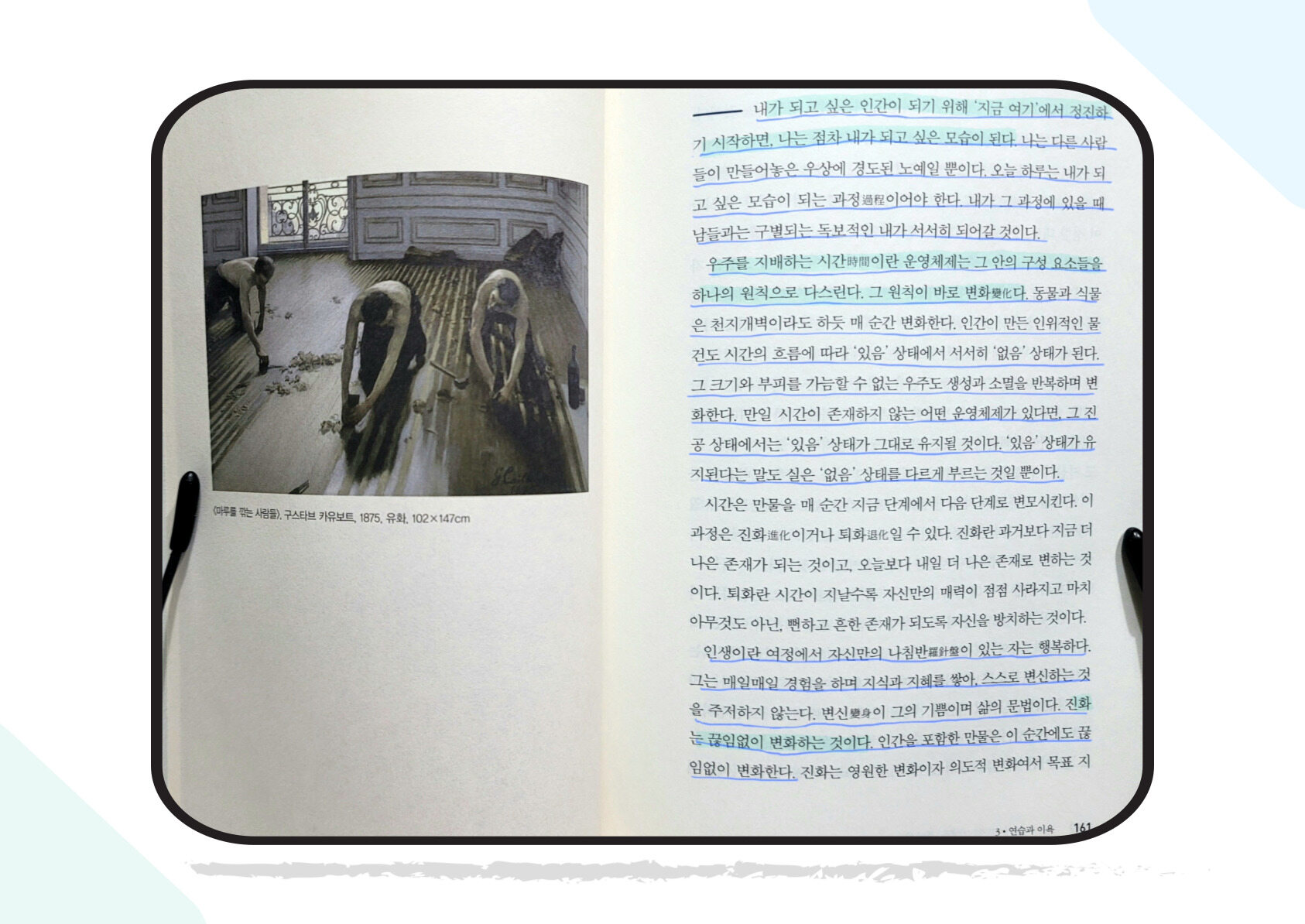
- 접기
꿈독 2023-03-04 공감(1) 댓글(0)
Thanks to
공감
배철현의 요가수트라 강독1 삼매, 파탄잘리, 요가 역사의 바이블
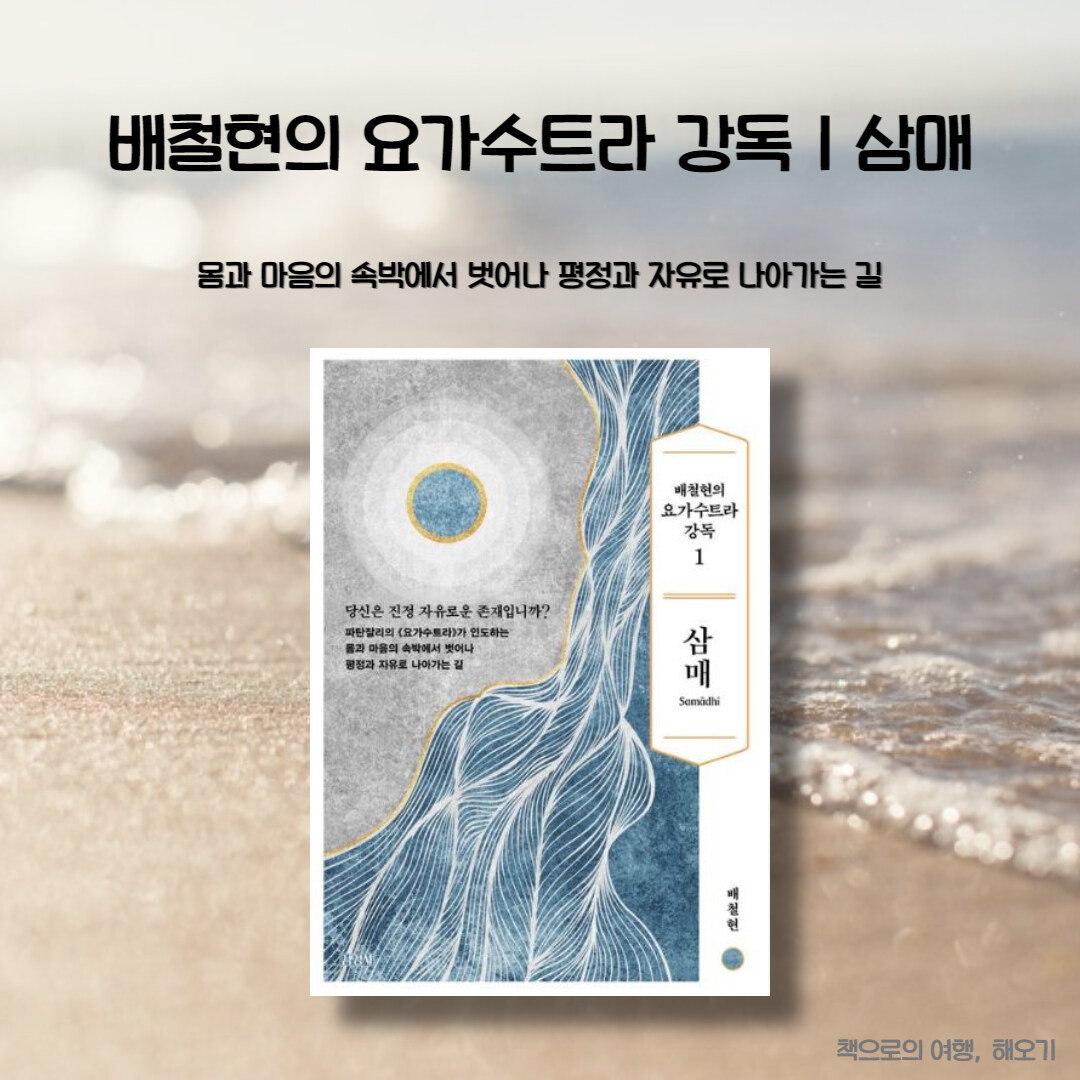
요가 역사의 바이블이라 불릴만한 책이 나왔다. 배철현의 요가수트라 강독1 삼매이다. 이 책 1. 삼매 편에 이어 2. 수련, 3. 현현, 4. 독존이 계속 출간될 예정이다.
먼저 배철현의 요가수트라 강독1 삼매는 요가 역사, 시조라 불릴만한 철학을 모두 망라해 놓았다. 파탄잘리가 누구이고 어떻게 요가가 시작되었는지 등을 담고 있다. 꽤 정교하고 심오한 표현이 많아서 한번 읽어서는 와닿는 것이 없을 수도 있다. 그래서 이 내용을 자세히 들여다볼 필요가 있겠다.
배철현의 요가수트라 강독1 삼매를 처음 접근하기에는 철학이나 종교 내지는 먼 과거의 이야기부터 시작하여 어려울 수 있을 것이다. 그러나 마음을 비우고 한 번에 이해하려 들지 말고 훑어보고 목차를 보고 궁금했던 부분부터 보아도 이 책의 매력에 빠지게 될 것이다. 그렇게 한다면 배철현의 요가수트라 강독1 삼매를 읽는데 부담으로 다가오지 않을 것이다.
배철현의 요가수트라 강독1 삼매는 500페이지 정도의 양에 처음에는 주춤할 수 있겠지만 요가에 대해 뜻이 있고 특히 요가를 사랑하는 사람이라면 그 어원이나 뜻, 시조를 알게에 더없이 좋을 것이다.
나 또한 잠깐이지만 예전에 요가를 가르쳐본 사람으로서, 여전히 요가를 사랑하고 즐기는 사람으로서 배철현의 요가수트라 강독1 삼매를 접할 때 너무 흥분되고 이론적으로 배울 수 있는 것이 있다는 점에서 기대가 되었다. 그런데 배철현의 요가수트라 강독1 삼매는 이론서도 아니고, 수련서도 아니었다.
배철현의 요가수트라 강독 시리즈가 뒤에 출간될 서적은 수련이나 방법 등이 기재될 수 있겠지만 삼매 편은 요가의 철학과 종교적인 부분 그리고 마음을 논하고 있다.
지금은 잠시 수련은 쉬고 있지만 얼마 전까지 요가를 하면서 느끼는 바가 있었다. 요가는 정도가 없다는 것. 모든 운동이 그러할 것이지만 특히 요가는 운동이라는 개념보다 몸과 마음을 다스리는 수련과 같았다. 적어도 내겐 그런 느낌으로 다가왔다.
하루 정도 수련을 쉬면 몸이 알고 마음이 흔들리기 시작한다. 그리고 항상 수련을 시작하기 전에 내게 스스로 던졌던 말이 떠올랐다.
'내 안의 나를 바라보자'
간단한 것 같지만 이 말대로 하기가 쉽지 않다. 다 같이 하는 수련이다 보니 눈을 뜨고 거울로 나만을 바라볼 수가 없다. 다른 이의 동작이나 행동이 눈에 들어오고 그러다 보면 내게 몰입할 수 없었다. 그래서 아예 맨 뒤나 맨 앞에서 수련을 할 때가 많았다. 나를 객관적으로 바라보고 남을 신경 쓰지 않는다는 것, 나의 호흡만을 바라보는 것 말이다.
수련생들을 가르칠 때도 그 말을 항상 했던 것 같다.
'나를 봅니다, 남과 비교하지 않고 어제의 나와 오늘의 나를 봅니다. 오늘의 몸 상태 마음 상태에 따라 할 수 있는 만큼만 진행하도록 합니다'
왜 이런 말을 했을까 생각해 보니 내게 했던 말이었다. 내가 요가 초심자였을 무렵, 왜 그렇게 안되는 어려운 동작을 따라 하려고 했는지 보면 욕심이 많았던 것 같다. 안 되는 것을 무리해서 하다 보면 호흡에 가빠지고 자세 또한 흐트러진다. 억지로 해서 될 것도 아니고 요가는 시간이 해결해 줄 것이었는데 욕심을 부렸던 것 같다.
배철현의 요가수트라 강독1 삼매에서도 말하길, 요가 수련자는 매일 정진할 것을 기본으로 삼고 있다. 컨디션에 따라 몸이 따라 주진 않을 수도 있다. 그런 것은 큰 문제가 되지 않는다. 그냥 하는 것이다. 매일매일.
나는 요가 수련을 하면서 선생님께 호흡에 대해 잘 배웠었다. 자세는 시간이 지나고 하다 보면 늘지만 호흡은 의식해서 계속 이어가 주지 않으면 몸도 자세도 흐트러진다. 그것은 시간이 해결해 주지 않는다. 처음부터 자세보단 호흡 중심으로 배웠었다. 그게 참 다행이고 멋진 경험이라 생각한다.
호흡이 빨라지는 자세나 컨디션이라면 그날은 절대 무리하지 않았다. 내가 할 수 있는 만큼만 다가갔고 정신을 가다듬었다. 프라냐야마 호흡법을 잘 익혔기에 수련 함에 있어 크게 힘들지 않았다. 그 호흡법을 수영할 때도 프리다이빙할 때도 써먹었었다. 가빴던 호흡을 금세 되돌릴 수 있었던 것 같다.
요가에서는 호흡을 중시한다. 아기 때는 배로 복식 호흡을 하고, 어른이 돼서는 가슴으로 흉식 호흡을 한다. 나이가 들면 어깨로 호흡을 하며 가쁘게 숨을 쉰다고 한다. 복식, 흉식 호흡을 익혀서 때에 따라 호흡을 조절한다면 지금보다 훨씬 육체적 건강함과 정신적 희열을 가져다줄 것이다.
오늘은 배철현의 요가수트라 강독1 삼매를 읽어 보았다. 요가를 사랑하는 사람이라면 꼭 읽어보고 요가의 철학, 시조를 알길 바라는 마음이다. 비록 두꺼워서 지레 겁먹을 수 있겠지만 괜찮다. 배철현의 요가수트라 강독1 삼매는 곁에 두고 차근차근 틈날 때마다 읽어 볼 만한 책이다. 한 번으로 절대 알지 못할 것이다. 나도 이 책을 지원받아 읽었지만 쭉 내 곁에 두고 요가에 대해 깊게 탐독할 생각이다. 요가를 사랑하는 한 사람으로 배철현의 요가수트라 강독1 삼매는 꼭 읽어 봐야 할 책이라고 생각한다.
이 책을 읽어야 할 사람은
· 요가를 사랑하는 사람
· 요가를 가르치고자 하는 사람
· 요가의 역사와 시작이 궁금한 사람
· 몸과 마음의 속박에서 벗어나 평정과 자유로 나아가고자 하는 사람
· 일상 속 요가 수련으로 본연의 자신을 찾고자 하는 사람
인상 깊었던 구절
요가는 온전히 경청하기 위해 몸의 소리를 경청하는 훈련이기도 하다. 우리가 요가 수업을 시작하기 전에 눈을 감는 이유가 있다. 만일 내 몸이 나에게 하는 말에 주의를 기울이면 나는 몸을 함부로 사용하지 않을 것이다. 요가는 나의 자연적인 모습 그대로를 전적으로 수용하고 인정하는 연습이다. p70
파탄잘리는 "요가는 의식에서 일어나는 동요를 잠잠하게 소멸시키는 행위다"라고 말한다. 꾸준히 수련한다면 의식에서 항상 요동치는 무지와 이기심이라는 소용돌이를 소멸시킬 수 있다는 뜻이다. p79
요가 훈련을 위해 고려해야 할 세 부분이 있다. 자세, 호흡, 그리고 응시점이다. 이 세 가지는 '트리스타나'라고 불리는데, 몸과 마음을 통해 삼매로 가는 데 걸림돌이 되는 부수적인 것들을 제거하는 실질적인 도구들이다. p244
요가 수련자는 자신의 목적지를 알고 있다. 그는 시위를 떠난 화살처럼 뒤돌아보지 않고 목적지를 향해 나아갈 뿐이다. 그는 수련을 방해하던 욕망을 버리고 온 정성을 다해 수련에 집중한다. (중략) 요가 수련자는 일상에서 자, 비, 희, 사 등 네 가지 마음을 실천하여 자신이 가야 할 길을 선명하게 인식하는 명료함을 획득한다. p354
기러기는 나는 동안 뒤를 돌아보는 법이 없다. 자신이 가야 할 곳을 알고 있다. 자신이 가는 곳을, 가야 할 곳을 아는 동물은 행복하다! 그곳은 자신들이 가야만 하기에 온 힘을 동원할 수 있는 유일한 목적지이기 때문이다. p480
<출판사에서 도서를 지원 받아 작성하였습니다>
- 접기
난e 2023-02-20 공감(1) 댓글(0)
Thanks to
공감
진정한 자유를 찾으려는 존재들을 위한책
#삼매 #samādhi
#배철현
#배철현의요가수트라강독1
잡념이 없는 상태에서 하나의 목적에 정신을 모으는 경험한다는 것은 어떤 느낌일까?
#독서삼매경에빠지다
그 상태에서 지혜와 해답을 얻는다는 것은 너무 판타지다운 일이다.
배철현 교수는 요가로 자유로운 존재로 나아간다고 서문을 열며, 구전으로 내려온 전통의 요가를 정리하여 기록한 파탄잘리의 「요가수트라」를 해석했다. 요가의 언어 산스크리트의 의미, 요가의 역사, 요가수트라의 확산 및 영향, 그리고 파탄잘리에 대해 학자다운 모습으로 쉽게 설명한다. 깔끔한 문장들은 정말 곳곳이 감동이다. 그리고 경이로운 그의 지식과 함께 경전 설명을 시작한다.
배철현 교수님 글에는 경이, 숭고, 찬란, 영적인 느낌이 있다. 이 책은 그의 찬란하고 견고한 문장들에 소름이 돋는다. 장황함이 없고, 둘러 가는 것 같지만, 본질에 도달해 있는 듯하다.
심연의 뜻 품은 경전 설명이 온전하게 받아들이기가 힘든건, 아마도 나의 부족한 역량 때문이라…. 죄송한 마음이 들었다. 한 번 읽어서는 안 되는 책이라는 사실을 인정하고 하루씩 나누어 읽는다. 경구의 해석은 여러 번 읽어야 할 것 같다. 성경책을 한 번 읽는다고 내용을 안다고 말할 수 없는 것과 같으리…. #천천히읽기좋은책
체계적이며 논리적인 명상 훈련인 요가를 통해 출렁이는 마음을 가지런히 정리하려 노력하고, 자신이 경험한 무언가에 집착하는 마음에서 벗어나 환희를 만끽하기 위해…. 평정과 자유를 획득하라고 말하고 있다. (63쪽. 인용)
몸을 자유자재로 쓸 수 있다면, 어떤 기분일까? 마음은 내 마음대로 못 하더라도 몸은 내 맘대로 할 수 있지 않나? 그렇게 생각해보지만, 절대 몸도 내 맘대로 안된다. 몸도 마음도 훈련을 통해서 운용할 수 있지, 절대 의도대로 움직여지지 않는다.
‘지금’에 몰입하고, 황홀을 느끼는 것이 요가이고, 요가에서의 황홀은 삼매이다. 요가를 통해 자신과 더 친밀해지고, 심연의 소리에 경청하며, 그대로의 모습을 수용하고 연습하는 과정에서 자기 삶의 변화를 맞이 훈련이다. (70쪽, 인용)
요가는 생각을 소멸시키고, 본연의 나를 바라보면서 초월적 자아를 경험하게 되며, 왜곡 없이 가짜를 찾아낸다.
몸과 마음의 다스리는 종합적 수련 장치로 요가의 뜻을 조금이나마 알게 되었다. 막연하게 요가가 좋다 그러던데…. 라고 생각하였다면, 요가를 통해 나는 자유를 얻을 수 있구나! 라고 바뀐다.
그렇다면 이제 실행에 옮겨야 할 텐데….
실행으로 옮기기까지 시간이 좀 걸리겠지만, 넓고 열린 가능성을 가지고 노력해 보겠다.
요가를 전문적으로 수행하시는 분이나, 요가에 관심을 가지고 싶은 분에게 큰 도움이 되는 책이 될 것이고, 나처럼 배철현 교수를 좋아하는 분들과 종교적인 접근 아닌, 학자의 시선으로 바라보는 경구 해석에 관심이 있으신 분들에게 아주 좋은 책이 될 것 같다.
〈삼매품〉의 51개 경구는 단순한 형이상학적 이론이나 사상이 아니다. 한 주에 한 구절씩 읽으며 사유하고, 그 뜻을 자신의 일상에 적용하며 실천하며 수련해보길 권한다. 내 생각과 말, 행동을 무의식적으로 장악하고 있는 집착에서 벗어나, 본연의 자기를 발견하고 영적인 자유를 얻게 될 것이다. -출판사 홍보문구 발췌-
#김영사출판사 #김영사서포터즈16기
지원받은 도서이며, 주관적으로 읽고 독후활동 하였습니다.
#감사합니다.
- 접기
어진슬기 2023-02-23 공감(1) 댓글(0)
Thanks to
공감
요가는 나를 응시하는 것, 배철현의 요가수트라 강독1: 삼매
<배철현의 요가수트라 강독 1 : 삼매> 는 요가 산맥 봉오리를 향해 올라가다 만나는 고전문헌과 역사적 배경, 위대한 종교 철학은 요가수트라를 이해하는데 큰 도움을 준다. 크리스천으로 만나는 인도, 불교의 산맥들은 다소 소화하기 힘들었지만 배철현 작가의 탁월한 해설 언어는 쉽게 접근할 수 있었다. 낯선 땅으로 여행 <요가수트라>는 경구 하나하나를 켜며 오르는 수련들로 삶, 생각에 입혀진 반복적 습관이 될 것이다. 고대 문헌도, 산스크리트어를 전혀 모르더라도, 천천히 한 구절씩 읽어나가며 원전의 뜻을 곱씹는 즐거움과 성취감도 느낄 수 있었다.
<요가수트라>를 삶에 적용하여 수련자의 몸, 마음, 영혼을 변모시키는 데 있는 요가는 인간의 의식을 훈련하여 영적으로 자유로운 상태로 진입하려는 통합적인 수련이다. 수련을 통해 인간 내면으로 찾아 들어가 전인적인 스스로가 나를 만나 완전히 다른 존재로 거듭난다는 것이다. 자신이 원하는 이상적인 모습으로 변화한다.
- 접기
pjr0609 2023-02-28 공감(0) 댓글(0)
Thanks to
공감

